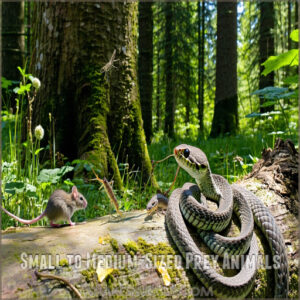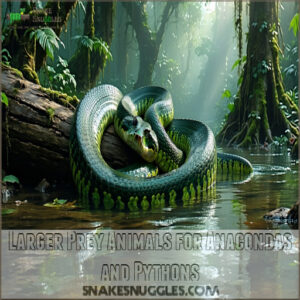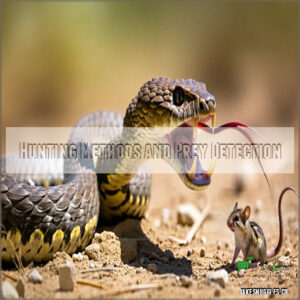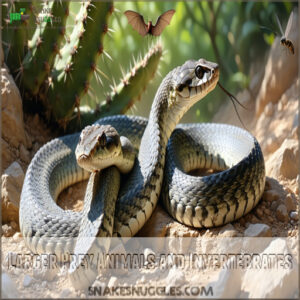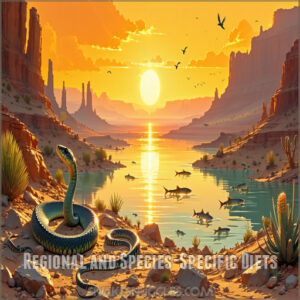This site is supported by our readers. We may earn a commission, at no cost to you, if you purchase through links.
 Snakes in the wild are picky eaters, but their menu mostly consists of small animals, including mammals like mice and voles, and other reptiles.
Snakes in the wild are picky eaters, but their menu mostly consists of small animals, including mammals like mice and voles, and other reptiles.
Their diet depends on their size and species—some snakes feast on insects, while larger snakes like pythons and anacondas take on deer and rabbits.
These scaly predators are strict carnivores, packing a powerful punch with their digestive juices to break down bones and extract maximum nutrition.
Their efficient systems allow them to go for long periods between meals, making them the ultimate calorie-saving experts.
Stay tuned to learn more about these fascinating creatures’ wild dining habits!
Table Of Contents
Key Takeaways
- Snakes are strict carnivores, and their diet consists of small animals, including mammals, reptiles, amphibians, birds, and insects.
- The size and species of a snake determine its diet; larger snakes like pythons and anacondas prey on deer and rabbits, while smaller snakes feast on small animals.
- Snakes have a highly efficient digestive system, allowing them to swallow prey whole and go for extended periods between meals, making them experts at saving calories.
- Their flexible jaws enable them to consume prey larger than their heads, and their powerful digestive juices break down bones to extract maximum nutrition.
Snake Diet and Biology
You’ll find that a snake’s highly efficient digestive system enables it to swallow prey whole, often larger than its own head, thanks to specialized jaw ligaments and elastic skin.
As strict carnivores, these remarkable reptiles can’t process plant matter, so they’ve evolved to extract maximum nutrition from their prey, with digestion times ranging from several days to weeks depending on meal size.
Carnivorous Nature and Digestive Tract
A snake’s digestive system is a true marvel of natural engineering.
As strict carnivores in the food chain, they’ve evolved remarkable adaptations for their wild nutrition needs.
You’ll be fascinated by how these carnivorous reptiles process their meals:
- Their digestive tract is shorter than other reptiles, maximizing meat consumption efficiency
- Powerful stomach acids break down whole prey, bones and all
- They can expand their digestive system up to 4x its normal size
- Specialized enzymes dissolve even tough prey items
- The process can take days or weeks, depending on meal size
This unique combination of traits allows snakes to thrive in their environments, making them one of the most successful groups of animals on the planet, with their digestive system being a key factor in this success.
High-Calorie Food Requirements and Eating Habits
While most animals need daily meals, wild snake diet patterns follow a fascinating "feast or fast" approach.
Their unique digestion process can stretch a single meal across weeks, making their calorie intake incredibly efficient.
Think of it like a solar-powered home: they store and use energy sparingly, converting food sources into long-lasting fuel.
Young snakes show different eating patterns, needing more frequent snake prey items to fuel their faster metabolism.
Their nutrient needs get met through whole-prey meals that provide a complete nutritional package.
A python’s remarkable efficiency shows in the numbers – they lose only 0.004% body mass daily while fasting.
That’s why snake feeding behavior varies from weekly to monthly meals.
Understanding snake diet habits is vital to appreciating these unique feeding behaviors, which involve a unique digestion process and result in incredibly efficient calorie intake.
Flexible Jaws for Swallowing Large Prey
You’d be amazed by nature’s engineering: feeding mechanisms that let these reptiles swallow prey larger than their heads.
The jaw anatomy works like a high-tech puzzle, featuring:
- Highly specialized ligaments that stretch like rubber bands
- Multiple hinge joints in the skull for maximum flexibility
- Backward-pointing teeth that grip prey during swallowing
This unique design trades crushing power for incredible flexibility, making those jaw-dropping meals possible.
The ability to consume large prey is due to their flexible jaw structure that enables them to open their mouths incredibly wide, which is a result of their highly specialized jaw anatomy and incredible flexibility.
Prey Preferences in The Wild
You’ll find that snakes are highly selective predators, with each species targeting specific prey from tiny insects to medium-sized mammals based on their hunting adaptations and habitat.
While smaller species like garter snakes might snack on earthworms and frogs, you can expect larger constrictors like pythons to tackle more substantial meals such as rabbits and deer, which is a result of their selective predators nature.
Small to Medium-Sized Prey Animals
Deep in nature’s dining room, wild snake nutrition centers on small to medium-sized prey that’s easily digestible.
You’ll find most snakes targeting rodents, small mammals, and reptiles as their primary food source.
What snakes eat varies by species – garter snakes feast on mice and voles, while king cobras prefer other snakes and lizards.
Snake prey selection depends heavily on habitat and availability.
Insect consumption is common among smaller species, while medium mammals like rabbits and squirrels satisfy larger snakes.
Most fascinating is their ability to swallow prey whole, sometimes 1.5 times their head size.
Larger Prey Animals for Anacondas and Pythons
You might think mice are a big meal, but that’s just an appetizer for these titans.
While anacondas and pythons typically feast on rabbits and rats, they’re capable of tackling prey that’ll make your jaw drop – quite literally, as they unhinge theirs to swallow massive meals.
- Green anacondas lead the pack, taking down hefty mammals and fish in their watery domains
- Burmese pythons adapt to new territories, sampling various local specialties
- Reticulated pythons prove surprisingly nimble, hunting prey several times their size
Hunting Strategies Using Venom and Constriction
While big constrictors like pythons and anacondas rely on pure muscle, venomous snakes deploy sophisticated venom delivery systems to take down prey.
You’ll find two distinct hunting tactics: ambush predators use lethal injections through hollow fangs, while constrictors employ powerful coils for prey immobilization.
These strike techniques evolved to match specific prey – from quick rodents to slower reptiles.
In nature’s arms race, both constriction methods prove equally effective.
Hunting Methods and Prey Detection
You’ll be amazed at how snakes use their specialized Jacobson’s organ and forked tongue to detect prey’s chemical signals, much like a built-in GPS system for finding their next meal.
Their hunting toolkit also includes heat-sensing pit organs and incredible jaw bones that can pick up the tiniest vibrations, making them nature’s ultimate tracking experts.
Keen Sense of Smell and Tracking Abilities
Think of a bloodhound’s tracking precision – that’s how the remarkable scent detection system works in nature’s stealth hunters.
The specialized Jacobson’s organ analyzes chemical signals with incredible accuracy, giving these predators a three-dimensional "smell picture" of their surroundings.
Like having a built-in GPS for prey location , this super-sense helps them navigate their environment and find their next meal with deadly efficiency.
Snakes also utilize prey detection methods to track and capture their prey effectively.
Use of Tongue for Information Gathering
Your fork-tongued friend isn’t just showing off – it’s wielding nature’s most sophisticated GPS system.
Through rapid tongue flicking, these sensory organs collect chemical signals from their environment like a 3D scanner.
Here’s what makes this biological marvel work:
- Fork tips spread wide to sample ground chemicals
- Stereo "smell" creates detailed environmental maps
- Chemical gradients reveal prey locations
- Constant sampling builds real-time tracking data
This system is a remarkable example of how nature’s most sophisticated tools can be found in the animal kingdom, and the biological marvel of the fork-tongued creature’s GPS system is a testament to the incredible complexity of natural systems.
Jacobson’s Organ for Prey Distance and Type Determination
While those forked tongues collect airborne particles, they’re actually just messengers for the real mastermind: the vomeronasal system’s Jacobson’s organ.
This remarkable sensory detection hub, positioned in the mouth’s roof, acts like a chemical supercomputer for snake prey capture.
You’ll find this organ processing chemical cues with incredible precision, enabling flawless prey localization, it’s nature’s version of smell in stereo, perfecting snake foraging strategies.
Common Wild Prey for Snakes
You’ll find snakes munching on everything from tiny earthworms to medium-sized mammals in their natural habitat, thanks to their incredibly flexible jaws and specialized digestive systems.
Whether you’re watching a python tackle a deer or a garden snake snag an unsuspecting mouse, these remarkable predators can handle prey up to 1.6 times their own head size, making them formidable hunters with incredibly flexible jaws.
Larger Prey Animals and Invertebrates
You’ll be surprised by the diverse palate of snakes, especially in regards to larger prey animals and invertebrates.
They’re true opportunists, and their menu includes:
- Chuckwallas: Those chunky lizards lurking in the desert are a tasty treat for snakes.
- Bats and Grasshoppers: Snakes aren’t picky and will feast on these airborne critters.
- Birds and Small Mammals: From songbirds to mice, snakes are always on the hunt for a nutritious meal.
Snakes often target large prey animals in their natural habitats.
Snakes are always on the lookout for their next big catch!
Specific Prey for Larger Snakes
Curious about what’s on the menu for larger snakes?
Anacondas and pythons go big or go home, taking down hefty meals like capybaras and wild deer.
Their strategy revolves around targeting calorie-rich, larger mammal prey, demonstrating their patient and calculated approach to mealtime, even venturing into the occasional boar hunt.
Feeding Habits and Patterns
How often snakes eat depends on their size and the availability of food.
They can go for long periods without eating, and some larger snakes may only eat a few times a year, which relates to their size.
Frequency of Eating and Starvation Tolerance
Snakes are the epitome of efficient energy use, adapting to fasting and even hibernating seasonally.
They can go weeks or months without a meal, thanks to their slow metabolism and fat storage.
Here’s what you should know about their eating patterns:
- Snakes are the epitome of patience, waiting out periods of low prey availability.
- Their metabolism slows during food deprivation, conserving energy.
- Hunger cycles vary with age, species, and environment.
- Some snakes tolerate extended fasting periods, an adaptation to scarce food sources.
Their unique ability to survive without food for extended periods is a testament to their adaptation to environments where food may be scarce.
Live Prey Preferences and Refusal to Eat Dead Animals
Their instincts are uncanny, and their preferences are clear: snakes are hunters that crave the thrill of the chase.
In the wild, their finely tuned hunting instincts drive them to seek live prey.
Even in captivity, many snakes respond best to feeding techniques that mimic this natural hunting experience.
A wriggling thawed mouse or a drop of chicken broth to enhance the scent can stimulate their appetite.
Why this preference?
Snakes are all about the thrill of the chase—dead prey lacks motion, and with it, the excitement of the hunt.
While most snakes prefer live prey, captivity can alter these preferences over time.
Understanding the benefits of live prey feeding is essential for providing snakes with a stimulating and nutritious diet.
Importance of Researching Species’ Dietary Needs
Understanding a snake’s refusal to eat dead animals is like gaining access to a room full of picky eaters.
Each snake species has its unique dietary preferences, and knowing the difference between captive and wild snake diets is vital for their health.
This knowledge guarantees you provide the proper nutrition and feeding frequency, accounting for prey availability and regional variations.
To meet their nutritional needs, one must determine if they require dietary supplements to meet their nutrient requirements and maintain their health.
Providing the right snake food supplements can substantially impact the overall well-being of snakes in captivity.
Regional and Species-Specific Diets
You’ll discover how a snake’s habitat influences its prey selection, from the desert viper’s preference for scorpions to the fish-eating habits of aquatic snakes.
This section explores these fascinating regional and species-specific dietary adaptations, highlighting the diverse culinary landscape of the snake world.
Desert-Dwelling Snakes and Their Prey
Desert-dwelling snakes are nature’s survival experts, thriving in harsh conditions.
Their diet includes rodents, insects, lizards, birds, and eggs.
These dune-dwelling species are masters of arid hunting tactics, skillfully traversing sandy burrows in search of prey.
By controlling rodent and insect populations, they play a key role in maintaining the delicate balance of desert food chains.
So, what’s on the menu for these desert dwellers?
It’s a wild mix of small creatures, showcasing their adaptability and resilience in arid environments.
Desert snakes have evolved remarkable desert dwelling strategies to survive and thrive in these environments.
Regional Variations in Snake Diets
Where snakes call home shapes their dining habits.
From tropical jungles to arid deserts, geographic influences and prey availability lead to regional variations in snake diets.
- Tropical Snake Diets: Diverse prey and snake species thrive in these regions, offering a smorgasbord of options.
- Arid Area Adaptations: Snakes adapt to scarce resources in dry areas, making the most of what’s available.
- Evolution’s Influence: Over time, evolutionary pressures craft niche-specific diets, ensuring snakes’ survival in their habitats.
Species-Specific Diets for Different Snake Species
Snake dining showcases diverse menus, with species-specific diets dictating unique prey choices.
The petite Corn snake relishes mice, while the mighty King cobra, a venomous giant, opts for larger fare.
Size and venom influence dietary preferences, creating a global snake cuisine spectrum.
Snake prey variation is fascinating, reflecting their adaptive prowess, and showcasing dietary specialization.
From tiny treats to formidable feasts, snakes master the art of nutrient acquisition from varied food sources.
Understanding proper reptile diet plans is essential for maintaining healthy snakes in captivity, highlighting the importance of reptile diet plans and nutrient acquisition.
Frequently Asked Questions (FAQs)
What do snakes most commonly eat?
Snakes are carnivorous, so they eat other animals.
In the wild, they typically go for small mammals, birds, reptiles, amphibians, fish, and insects.
It’s a diverse menu, but they’re not into veggies.
What do non-venomous snakes eat?
Non-venomous snakes are still carnivores, so they eat a meat-based diet.
They’re opportunistic hunters, feasting on small mammals, birds, reptiles, amphibians, and insects.
They swallow prey whole, no matter the size.
Will a snake eat a squirrel?
A squirrel? Sure! Snakes are opportunistic eaters with flexible diets. Their jaws stretch wide, so a squirrel could be on the menu for larger snakes looking for a hearty meal.
What eats snakes in a yard?
Your yard may host a mini-ecosystem of snake predators.
Birds of prey, wild boars, coyotes, foxes, and even other snakes are among the creatures that could be eyeing your slithery visitors for their next meal.
What do snakes eat in the desert?
Desert snakes, like their non-desert counterparts, are carnivorous and feed on a variety of prey. Their diet includes small mammals, birds, reptiles, amphibians, and insects, depending on the species.
What do snakes eat?
So, what do snakes actually eat?
Well, these guys are carnivores, meaning they chow down on meat and nothing else.
They’re opportunistic hunters, so they’ll eat whatever prey they can get their hands on.
Do snakes eat other snakes?
Yes, some snakes do eat other snakes. This behavior is known as inter-species snake-eating, and it’s not uncommon in the slithery serpent world.
What snakes eat insects?
Corn snakes, garter snakes, and some smaller species are insectivores. Their diet includes crickets, caterpillars, moths, and grubs—a tasty bug buffet!
What are snakes’ favorite foods?
It’s a snake’s world, and we’re just living in it—with over 3,000 species, they’ve got dining down to an art.
Their favorite feast? Small to medium-sized prey, like rodents and birds.
Will snakes eat squirrels?
Squirrels are on the menu for some snakes, especially if they’re looking for a hearty meal.
Snakes are opportunistic hunters, so if a squirrel happens to cross their path, it could become their next feast.
Conclusion
Unraveling the dining habits of snakes in the wild is like exploring a culinary adventure in the serpentine world.
From mice to massive prey, these scaly predators are the ultimate picky eaters, tailoring their menus to their size and species.
Now you know that snakes are strict carnivores, with impressive digestive systems that can break down bones and go long periods between meals.
So, the next time you spot a snake, remember it’s a master calorie-saver, an expert hunter, and an integral part of nature’s delicate balance.
- https://www.discoverwildlife.com/animal-facts/reptiles/what-do-snakes-eat
- https://www.crittercontrol.com/wildlife/snakes/snake-diet/
- https://www.petmd.com/reptile/nutrition/what-do-pet-snakes-eat
- https://blog.nwf.org/2011/12/7-jaw-dropping-facts-about-what-snakes-really-eat/
- https://myfwc.com/wildlifehabitats/profiles/reptiles/snakes/burmese-python/


